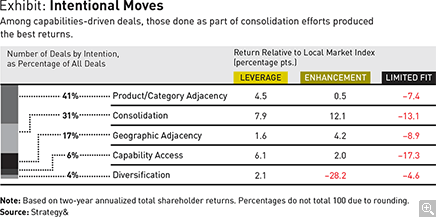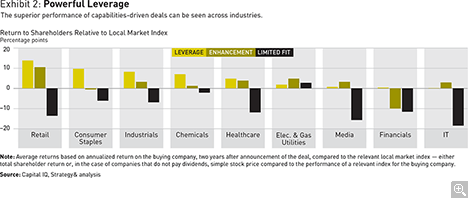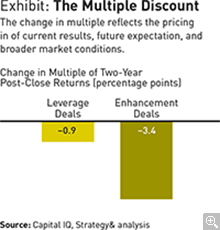Deals that win
Twelve years of data shows that mergers and acquisitions that apply or enhance capabilities produce superior returns.
A version of this article appeared in the Autumn 2015 issue of strategy+business.
In May 2015, industrial conglomerate Danaher agreed to buy the Pall Corporation, a maker of biopharmaceutical and medical products, for US$14 billion. Although it was far from the biggest deal of 2015 — plenty have dwarfed it — Danaher–Pall attracted a lot of attention from those who work in corporate mergers and acquisitions. The deal is intriguing for two principal reasons. First, Danaher announced it would split into two companies after the transaction, one focused on manufacturing and the other on life sciences and diagnostics, each company possessing a unique capabilities system. Second, this was the largest transaction ever completed by this highly active, highly competent acquirer. Danaher has made more than 400 acquisitions over the last 30 years, and a startlingly high percentage of them have worked out well.
Danaher’s success in M&A stems from the fact that it knows its area of greatest strength — an approach to continuous operational improvement known as the Danaher Business System — and concentrates on targets that can benefit from it. Put another way, Danaher is a capabilities-driven acquirer that leverages its capabilities across its many acquisitions. And as it turns out, focusing on targets that leverage one’s capabilities provides the greatest chance of M&A success, not just for Danaher but for any big company at just about any point in time.
Focusing on targets that leverage one’s key capabilities provides the greatest chance of M&A success.
This is the main lesson that emerges from Strategy&’s most recent study on the role of capabilities in M&A success. When we examined 540 major global deals in nine industries announced between 2001 and 2012, we found that deals that leveraged the buyer’s key capabilities or helped it acquire new ones produced significantly better results, on average, than local stock market indexes in the two years following the deal. And they produced better results than deals done with other rationales in mind. The overall premium for capabilities-driven deals above other types of deals was a 14.2 percentage point compound annual growth rate (see Exhibit 1) — even higher than the first time we did the study, in 2012, when we analyzed transactions that took place between 2001 and 2009. This year’s study was also more comprehensive, and included hundreds of deals that weren’t in the original study. (See Methodology.)
Although only about half of the individual deals we studied helped the acquirers beat the local market index, the success rate of deals done with clear capabilities rationales was considerably higher; more than six in 10 capabilities-driven deals earned a premium. By contrast, only one-third of deals not taking account of capabilities (“limited-fit” deals, in our vernacular) showed returns that were above the local market index. The companies that were the most successful acquirers over the period of our study, such as Walt Disney Company and Abbott Laboratories, seem to implicitly understand the importance of taking a capabilities-driven approach to M&A, and focusing on building scale around their capabilities systems — that is, the three to six things they do uniquely well to create value for customers. These companies may not always describe their M&A activities using capabilities terminology, but their transactions nonetheless reflect a calculated awareness of what they already do — or could do — extraordinarily well.
In our schema of M&A, deals fall into three categories: leverage, enhancement, and limited fit. Leverage deals are situations in which acquirers buy companies that they know or believe will be a good fit for their current capabilities system; for instance, a big pharma company buys a smaller competitor in order to extend its marketing capabilities in a therapeutic area both companies serve. Enhancement deals are designed to bring the acquirer capabilities it doesn’t yet have and that will allow it to intensify its own capabilities system. Limited-fit deals occur when the acquirer largely ignores capabilities; the transaction doesn't improve upon or apply the acquiring company's capabilities system in any major way. (Deals also fall into categories based on intent; see “What Are Your Intentions? Another Way of Thinking About M&A.”)
What Are Your Intentions? Another Way of Thinking About M&A
Often the main thing that companies focus on in deciding whether to do a deal is the intention of the deal. As shown in this chart, there is still a lot of appeal in buying something that is adjacent from a product or category perspective, according to an analysis of the 540 deals reviewed by Strategy&. Being a consolidator also offers significant appeal, as does gaining access to a geographic market that seems like a natural extension. No matter what the intention, however, deals typically do better if they have clear capabilities rationales.
Enhancement deals are inherently more complex than leverage deals. But when they work, they can have outsized returns for the acquirer. Think of Google’s 2006 acquisition of YouTube. The $1.6 billion transaction for the nascent video-sharing platform was far and away Google’s biggest at the time and propelled the search-engine company into uncharted territory. But nearly a decade later, with YouTube reaching more than a billion users per month and having a mindshare in online video not unlike the one its parent company has in search, few would question the thinking behind the deal. Indeed, information technology was a sector in which enhancement deals led to even higher returns than leverage deals over the period of our study (see Exhibit 2).
Our study has yielded further insights on the performance of different types of deals and ways in which companies can succeed as they choose their approaches.
Enhanced Returns
Although they again represented a relatively small part of our study sample, enhancement deals showed the most improvement in the 2015 compared to the 2012 study, outperforming the market by 2.6 percentage points on average. In our 2012 study, enhancement deals beat the market by half of a percentage point.
Enhancement deals, which companies make to acquire a capability that allows them to augment their system of capabilities, are especially common in industries facing major technological or regulatory shifts. During the period covered by our study, healthcare companies — especially U.S. healthcare companies facing intensifying competition and regulatory changes — did the most enhancement deals (23 out of our sample of 60), followed by information technology companies, with 16. Media companies were another big originator of enhancement deals, doing 14 of them. Traditional newspaper and television companies are facing enormous challenges to their advertising and customer franchises because of the Internet and mobile computing.
The $25 billion acquisition by drugstore chain CVS of Caremark Rx is one example of a successful, very large enhancement deal in healthcare. CVS bet that it would be able to cover the prescription drug market more effectively if it owned a pharmacy benefits manager like Caremark, which specialized in mail-order fulfillment and worked with big organizations, including corporations. The vertical-integration gambit paid off: Two years after the 2006 deal was announced, CVS’s shareholders had seen a 12 percentage point premium in annualized total shareholder return (TSR) versus the S&P 500. That premium has become even bigger; CVS’s shares have risen at a rate more than four times that of the S&P 500 since 2008, and have outperformed the shares of the company’s nonintegrated competitors (Walgreens, Rite Aid, and Express Scripts) by even more.
In the IT sector, successful enhancement deals included Micron Technology’s purchase of Elpida Memory in 2012. The U.S. company purchased Elpida, of Japan, to add expertise and manufacturing capacity in the area of mobile memory chips. The deal has been hugely successful, helping Micron to a two-year annualized TSR performance that was 129 percentage points higher than the S&P 500. (Enhancement deals are among the highest-return deals happening now in Asia; see “Enhancement Deals in Asia-Pacific: Outsized Returns.”)
Enhancement Deals in Asia-Pacific: Outsized Returns
From a geographic perspective, Asian companies obtained the best results by far of any region in our study when it came to enhancement deals. The annual total shareholder returns for enhancement deals in Asia-Pacific were a whopping 26 percentage points higher, on average, than those for limited-fit deals.
This is a result of companies in the Asia-Pacific region — and in particular, in the region’s still-developing countries — having a long way to go in their capabilities development. An industrial company in the U.S. might not be able to improve its operations or its marketing expertise very much by buying a company in Europe. But for a company in China, Indonesia, Malaysia, or Thailand, buying a smaller European company could work to its benefit for precisely these reasons. Chinese firms have been particularly active buyers in recent years, snapping up midsized European firms that are still reeling from the 2008 financial crisis but that have an abundance of advanced technology and engineering talent.
Companies in these still-developing parts of Asia are nowhere close to the international capabilities frontier, as it might be called, so buying Western companies can go a long way toward bringing them to parity. This march toward the capabilities frontier was a major factor in the acquisition of German company Putzmeister, a maker of high-tech industrial pumps, by Sany Heavy Industry, China’s biggest construction company, in 2012. Other prominent interregional deals in recent years, such as the acquisition by India’s Tata Motors of Jaguar Land Rover in 2008, the acquisition by China’s Geely of Volvo in 2010, and the stake that China’s Dongfeng Motor Corporation took in PSA Peugeot Citroen in 2014, likewise have big elements of capabilities enhancement.
If anything, we think our study, which looked at only the biggest deals, may understate the incidence of enhancement deals and overstate their risks. A lot of enhancement deals between 2001 and 2012 likely fell under the radar — meaning that they were too small to be included in this study. But some of the most active and successful acquirers of the past 15 years — U.S. insurer UnitedHealth Group, British brewer SABMiller, and French electricity distributor Schneider Electric — have done multiple small deals to enhance their capabilities.
Capabilities-driven companies know how to alternate between leverage and enhancement deals to achieve their growth objectives. In this respect, it may be necessary to make a special effort to communicate their rationale to Wall Street, because of the unique postmerger integration skills required for successful enhancement deals. Success relies less on quickly identifying and capturing synergies, and more on taking the time to find ways to manage cultural differences, retain essential people, and help those people’s ideas take root in the broader organization. (See “The Multiple Discount” for an additional look at the challenges surrounding enhancement deals.)
The Multiple Discount
Why don’t enhancement deals perform as well as leverage deals? From a TSR perspective, the biggest difference (two years after a deal’s close) is the price-to-earnings multiple of the acquirer. Strategy&’s study shows that doing deals takes a toll on multiples generally, but the negative impact is greater when the acquirer is taking on new capabilities. The downward multiple adjustment may reflect the fact that these deals are more complex and difficult to carry off successfully. In any event, the difference suggests that those doing enhancement deals should be vigilant not only in integrating their new pieces but also in making sure that everyone — including the investment community — understands the end goal.
Leveraging Up
Leverage deals are the most common type of capabilities-driven deal. In any given period, it isn’t surprising for the number of big leverage deals to be twice that of big enhancement deals. In the period covered by our study, leverage deals were also the most consistently successful deal type, earning 5.4 percentage points more than the local market on a compound annual basis and earning a premium over limited-fit deals of about 15 percentage points.
One of the better leverage deals in our study, the 2011 acquisition by SABMiller of Foster’s Group, was a European–Australian acquisition. SABMiller, a U.K.-based global brewer, saw an opportunity to improve Foster’s performance, which was hampered by Foster’s having a split portfolio — beer and wines — and the distractions that produced. (Foster’s spun off its wine business shortly before the deal with SABMiller was completed.) The deal produced an annualized two-year TSR premium of 17 percentage points above the relevant market index. Another successful leverage deal involving a Western buyer (premium: 41 percentage points) was in the industrials sector, when Hertz Global Holdings snapped up Dollar Thrifty to increase its presence at airports and strengthen its offerings in the mid-tier car-rental segment.
By their nature, leverage deals make the most sense where companies that already have advantaged capabilities can integrate products and services into their sophisticated, well-functioning systems. Chemicals, financial-services, and consumer staples companies were among the most apt to do big leverage deals in the period covered by our study; retailers got the highest returns on such deals. Leverage deals done in the developed world tend to have better returns than leverage deals done in developing regions (for example, Asia-Pacific) because many of the developing-world companies need to define their capabilities systems. (The number of big leverage deals done by Latin American, African, and Middle East companies over the period of our study was too small to allow for meaningful comparisons.)
One exception to the theme of Western dominance of leverage deals was the acquisition of Malaysia’s Titan Chemicals Corporation by South Korea’s Honam Petrochemical. The deal, struck in 2010, expanded Honam’s portfolio of ethylene- and propylene-related products and gave Honam a deeper presence in the developing markets of Asia. But as a South Korean company, Honam (which in 2013 merged with another South Korean firm, KP Chemical, to form Lotte Chemical Corporation) has more in common with Western companies than it does with developing-market companies. The high return it got on the Titan deal is therefore somewhat less surprising.
Limited-Fit Deals
Theoretically, we don’t have many positive things to say about deals that don’t begin with a capabilities rationale. The evidence suggests these deals usually lead to negative returns (compared to local market indexes), as happened in two-thirds of the limited-fit deals in our study. This finding holds across geographies and industries. There is also a fine line between a bad enhancement deal and a limited-fit deal. If an acquirer has miscalculated, some deals conceived of as adding important new capabilities to the acquirers’ systems in place can end up looking like limited-fit deals.
That said, some industries had a slightly better track record than others with limited-fit deals over the period of our study. Electric and gas utilities was the only sector to eke out a positive return with limited-fit deals. Chemicals companies did second best, and entered into fewer of these deals than any other industry save healthcare.
Limited-fit deals can work when they have a lot of consolidative potential — that is, when there is overlap between the acquirer and the target, and a chance to drive synergies in areas such as procurement, or to remove a significant amount of cost. That was certainly the case with R.J. Reynolds Tobacco’s purchase of Brown & Williamson Tobacco more than a decade ago. The deal (which produced a two-year premium of 42 percentage points annually versus the S&P 500) allowed R.J. Reynolds to consolidate redundant HQ, sales operations, and manufacturing operations and generate in excess of $600 million in annual savings. Successful limited-fit deals often don’t have much to recommend them in terms of a capabilities rationale, but they serve as a reminder that in business, execution sometimes trumps strategy.
Staying Flexible
The companies that seem to be most capabilities-driven in their deal making don’t stick to one deal type all the time. They may switch between leverage deals and enhancement deals depending on how much growth they think they can achieve in their existing markets and with their current capabilities systems.
For instance, Disney — which has certainly had success as an acquirer — has strategically toggled back and forth between leverage and enhancement deals in the past 15 years (see Exhibit 3). Its acquisition of Pixar (announced in 2006) was an enhancement deal: It gave Disney depth in the area of computer-generated animation, where Disney wasn’t strong. By contrast, its acquisition of Marvel Entertainment (announced in 2009) was a leverage deal that gave Disney a new cast of iconic characters to push through its film and television channels and to incorporate at its theme parks. In 2012 Disney undertook another enhancement deal, buying LucasFilm not just for its Star Wars franchise but for the smaller company’s leading-edge animation and visual effects technologies.
With a company as large as Disney, it’s sometimes hard to pinpoint the impact of a relatively small acquisition (each of these deals represented less than 10 percent of Disney’s enterprise value at the time it was announced) compared with the impact of other management decisions and actions. But Disney’s deals have helped redefine and strengthen the company, whose stock outperformed market indexes in the two years after these three deals were announced and, as of this writing, is trading close to an all-time high.
Besides sharpening the vision of prospective buyers, a capabilities lens can help a company figure out what doesn’t fit — and what it should therefore divest. The theory behind capabilities-driven divesting is simple: Get rid of the assets that don’t mesh with what you do best. These assets, which may be profitable, still distract companies from getting the most out of their capabilities systems. Ultimately, the assets that are clearly a good fit for the capabilities you have should get more funding so they can reach their potential.
General Electric’s announcement early in 2015 that it would sell off GE Capital, its long-standing finance unit, reflects what is essentially a capabilities-driven approach to divesting. In GE’s case, that doesn’t mean that it lacks the capabilities necessary for success in the areas of lending and credit. Rather, it means that maintaining these capabilities in light of intensifying regulatory scrutiny takes focus away from its core engineering-based capabilities. And in fact, every company’s thinking about which of its capabilities are indispensable, and which aren’t, should evolve in response to market changes and should be reflected in its M&A strategy.
On the day in May 2015 that Danaher announced its acquisition of Pall, its executives held a conference call with Wall Street analysts to discuss the deal, and to explain their decision, once the deal was done, to split Danaher into two companies. The company’s structure would change, but its fundamental approach would remain the same. The executives assured investors that both companies — the healthcare-focused company that will still be called Danaher and the as-yet-unnamed company that will focus on industrial products — will continue to rely on a zealous application of the Danaher Business System to create value for customers and returns for shareholders.
As for the split itself, separate companies will allow for the establishment of two distinct capabilities systems. Danaher’s executives said the primary reason for the the split was to give greater visibility into some existing businesses that have not had much access to merger capital. It turns out that Danaher has no intention of backing off from its use of inorganic growth tactics even after it becomes two companies. Given how it has done with M&A so far, no one would expect it to. ![]()
Methodology
Our study looked at the 60 biggest global deals by transaction value announced between 2001 and 2012 in each of nine target industries: chemicals, consumer staples, electric and gas utilities, financial services, healthcare, industrials, information technology, media, and retailing. The biggest deal captured by our filter was Pfizer’s $79.6 billion purchase of Wyeth in 2001; the smallest was John Fairfax Holdings’ $492 million purchase of Trade Me Group in 2006.
To measure the performance of these 540 deals, we took the acquiring company’s annualized total shareholder return (TSR) — stock price plus dividends — in the two years after the acquisition was announced. We then compared that with the TSR compound annual growth rate of the large-cap index in the acquiring company’s home country. (The benchmark indexes we used include the S&P 500 in the U.S., the FTSE 100 in the U.K., the CAC 40 in France, the DAX in Germany, and the KOSPI Index in Asia.) If the company didn’t pay dividends, the TSR was equivalent to the change in the company’s share price.
One part of the research requires some judgment: the classification of deals’ intentions, and especially the deals’ fit from a capabilities perspective. To help with this, we examined corporate announcements, external press coverage, and SEC filings. For the capabilities-fit classification, we ultimately relied on our judgment, our analysis, and our experience with these companies to determine whether the deals fundamentally leveraged, enhanced, or ignored the acquirer’s capabilities.
Some deals appeared to have multiple goals; for example, they were intended to both leverage and enhance capabilities. We slotted those deals into the single main category that we believed they fit best.
The sample group of 540 companies for this year’s study included 252 deals that were in our last study on the topic, published in 2012. Two hundred eighty-eight other deals were new to this study.
Reprint No. 00346
Author profiles:
- J. Neely is a leader with Strategy&, PwC’s strategy consulting group, and is based in Cleveland. He is a leader of the firm’s deals platform and is part of the consumer and retail practice.
- John Jullens is the emerging markets leader for the capabilities-driven strategyy platform at Strategy&. He is based in Detroit.
- Joerg Krings is a leader with Strategy& based in Munich. He heads the firm’s business efforts in the automotive industry as well as European M&A strategy.









